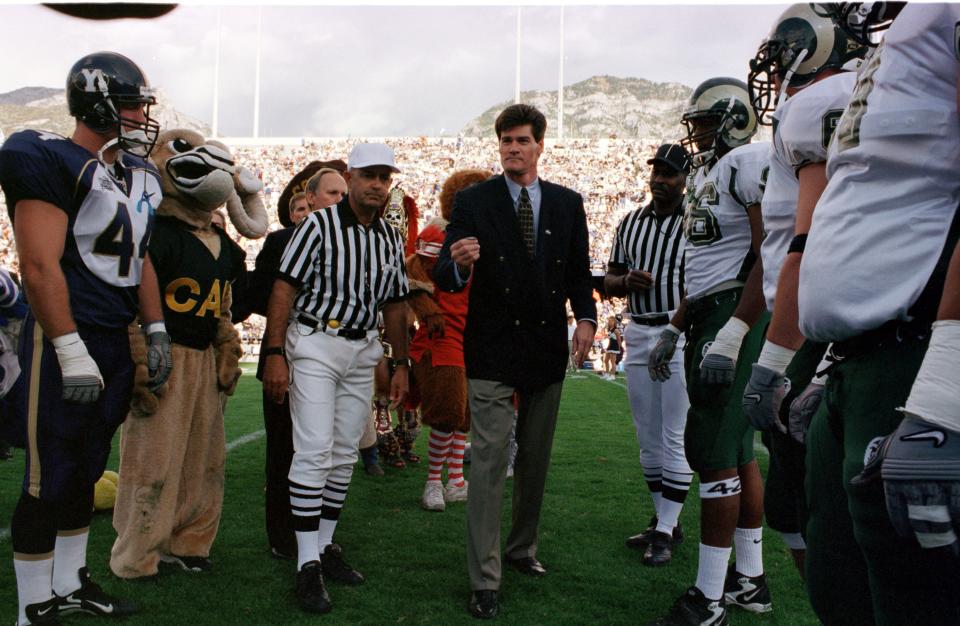Lyell: Colorado State to AAC only makes sense if Mountain West's demise is inevitable
As rumors about Colorado State’s impending move to the American Athletic Conference heat up, so do the questions.
Why would CSU want to move from one Group of 5 conference, the Mountain West, to another, the AAC, that is losing its top three programs — Cincinnati, Houston and UCF — to the Big 12?
Why abandon traditional rivals like Wyoming and New Mexico to instead play the likes of East Carolina, Temple and Tulane?
Why leave a conference CSU helped launch in 1999 to join one that looks a lot like the 16-team Western Athletic Conference it was escaping?
The answers are difficult to discern.
More: Colorado State to the AAC? National reports say move from Mountain West is in the works
The move only makes sense if you assume that the MW is falling apart.
And with Boise State, San Diego State and sometimes UNLV mentioned as possible future additions to the Big 12 and its Power 5 conference TV money and autonomy, that’s a distinct possibility.
CSU athletic director Joe Parker might have some inside information on that from his connections in the Big 12, forged during his previous jobs as a deputy AD at Texas Tech and senior associate AD at Oklahoma and Texas. He’s also a close friend of former Kansas AD Jeff Long.
If the MW’s demise is inevitable, CSU is better off moving now — along with Air Force, as national reports suggest — than being left behind a year or two from now.
But if there’s still a chance to save the conference, CSU System Chancellor Tony Frank, President Joyce McConnell and Parker should push their counterparts in the MW to become proactive in the realignment process rather than reactive.
They could push the MW to consider adding the three remaining AAC members with the most value — Memphis, Tulsa and SMU — in all sports, along with Gonzaga and Wichita State in men’s basketball and other sports the two nonfootball-playing schools offer.
Moving on: Two Colorado State football seniors say they are transferring
That would require a level of leadership within the MW that might not exist anymore, though. Leaders like former CSU President Albert Yates, who in 1998 convinced the presidents of BYU, Utah and Wyoming and the superintendent of the Air Force Academy to break away from what had become an unwieldly 16-team WAC and form a new eight-team conference that also included New Mexico, San Diego State and UNLV.
The MW made similarly bold moves by adding TCU in 2005 and Boise State in 2010, along with Fresno State and Nevada a few months later to solidify its position alongside the Pac-12 as the top athletic conferences west of the Mississippi River and the best football conference in the country outside of the six that had automatic berths for their champions in the Bowl Championship Series.
AAC commissioner Mike Aresco, a former TV executive, makes his intentions known far and wide while touting his conference as one of the “Power 6,” destined for the same autonomy within the NCAA framework and media-rights money now enjoyed by the Power 5 — Atlantic Coast, Big Ten, Big 12, Pac-12 and Southeastern conferences.
While most conference realignment moves revolve around money, that doesn’t necessarily apply in this case. Although AAC schools are receiving about $6 million a year from their current media-rights deal (TV and internet streaming) with ESPN that runs through 2031-32, that deal is subject to renegotiation if conference membership changes. It’s hard to imagine ESPN offering the conference much more than the $3 million-plus per year CSU receives from its media-rights package with CBS and Fox that runs through 2025-26.
The MW, as it stands, is far better poised than the AAC to increase that revenue sooner, given the shorter length of its existing contract.
The impact on other sports needs to be considered, too. Road trips to Wyoming, New Mexico and Utah State cost significantly less money and missed class time than trips to South Florida, East Carolina and Temple.
It’s possible that the MW, based in Colorado Springs and led by commissioner Craig Thompson since its formation, is working behind the scenes to prevent its demise. Thompson said as much in recent story in the San Diego Union-Tribune.

“We’re just as active,” Thompson told the Union-Tribune earlier this month. “We just don’t articulate it or put out an agenda saying here’s what we’re doing today. But we’re talking and strategizing.”
Thompson, of course, is urging the 11 full members and Hawaii, a football-only member, to stay put in the MW. Reports suggest the conference is already looking at possible replacements, though, for CSU, Air Force and possibly others down the road.
And the list of those potential candidates that have been tossed around — North Texas, UTSA, New Mexico State, Utah Valley and North Dakota State, among others — is alarming.
If that’s the best the MW can do, there’s no point in sticking around.
But if there’s still a chance to save the MW, as it exists, CSU would be far better off staying put in the conference it helped create 23 years ago than jumping ship now.
Kelly Lyell reports on CSU, high school and other local sports and topics of interest for the Coloradoan. Contact him at kellylyell@coloradoan.com, follow him on Twitter @KellyLyell and find him on Facebook at www.facebook.com/KellyLyell.news. If you 're a subscriber, thank you for your support. If not, please consider purchasing a digital subscription today.
This article originally appeared on Fort Collins Coloradoan: Colorado State to AAC only makes sense amid Mountain West demise

